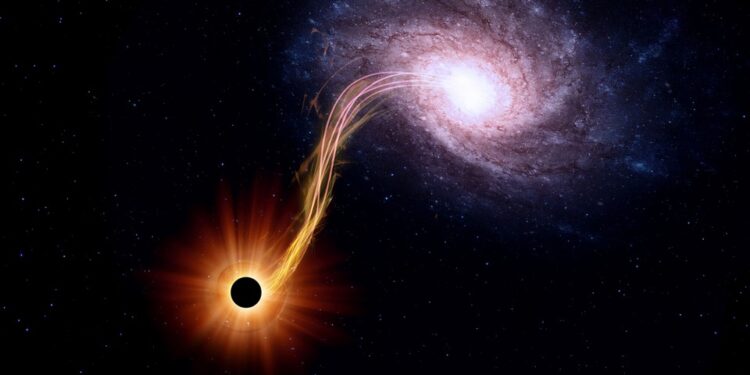Dr. Jonathan Kenigson, FRSA
Black Holes are often among topics of casual conversation among enthusiasts of physics and recreational mathematics. The very idea of a Black Hole – a singularity in Einstein’s Spacetime that nothing can escape –has inspired many a fertile imagination to speculate if such entities could be exploited for military or commercial purposes, or even used as an adjunct to power generation or manned spaceflight. The answers to these questions lie in the complexities of the mathematical models used to generate theories of Black Holes and their attendant dynamics. The purpose of the current series of essays is to explore these mathematical results in non-technical terms for the benefit of UK and global audiences alike.
Newton’s Mechanics does not predict the existence of Black Holes. This understanding of Mathematical Physics dominated mathematical understanding of mechanics until Einstein’s Theory of Relativity emerged in the early 20th century and predicted, among other counterintuitive results, that entities of infinite mass-density are permitted as solutions of the differential equations governing the curvature and energy-density of Spacetime (known as the “static and uncharged” or “Schwarzschild” solution). In fact, Spacetime is fashioned by the entities it contains, and conforms to the character of what is situated within it. If massive or charged objects spin, spacetime spins around them (a notion postulated in 1918 called “Frame Dragging”, discovered as a consequence of Relativity and known formally as the “Lense-Thirring Effect”). From 1916-1921, a handful of mathematicians and mathematically inclined physicists developed the so-called “Reissner- Nordström” metric, which was found to characterize the dynamics of a non-rotating Black Hole that possesses a charge. Without the complexities posed by Lense-Thirring, classical metric solutions of the Field Equations for a charged singularity became mathematically tractable. There was no mechanism postulated at the time for how a gravitational singularity could possess a charge, or how it could obtain one in a vacuum. The florid mathematical formalism of the result exploited deep knowledge of coordinate changes and the first physical application of sophisticated Differential Geometry to a proposed but unobserved physical phenomenon. The innovations presented by the RN solution were: (1). The explicit use of Tensor Calculus to model curves and curvature; (2). The exploration and quantification of Time Dilation to particles moving on a non-Euclidean surface; (3). The notion that charges – as energies – contribute to mass, so that the mass of the RN Black Hole is not static with respect to charge. This distinction is encapsulated by the inequality of RN rest mass with RN charged mass, which can be computed precisely using Tensor Mechanics.
It is conceivable that Black Holes – in addition to having a charge – should also be taken to rotate, even if ever-so-slowly. In fact, a fully general mathematical formalism should permit quantification of the dynamics of rotation at any speed whatever. When stars collapse, they often spin – White Dwarves and Neutron Stars have this property. The spin is often rapid and is affected by accretion of infalling matter that disturbs both the spherical symmetry of the system and the rotational momentum of the same. The simplest case of a rotating, uncharged Black Hole took nearly 50 years to determine, and was first postulated by Kerr in terms of Kerr-Schild Coordinates in the early 1960’s. Boyer-Linquist Coordinates quickly generalized Kerr-Schild’s initial approach and provided – among other novel connections – an explicit link with the so-called “Schwarzschild Radius” derived in 1918. The “Schwarzschild Radius” is the radius that a spherically-symmetric body of uniform mass M must possess to collapse into a stationary Black Hole. This quantity is obtained easily by modern students of Mathematical Physics by equating the Newtonian Gravitational Potential to the Kinetic Energy (motion energy) of an escaping particle, and then stipulating that this escape speed must be equal to the speed of light. The resulting radius is quite small for most objects of planetary mass but becomes a nontrivial quantity when stellar-mass objects are considered. The crux of Kerr’s theory is that rotation – like charge – is a form of energy, and thus, by the famous Einstein mass-energy equivalence – is also a form of mass. Later theorists sought to propose whether a rotating Black Hole could wither away all its mass via rotation. According to Einstein’s Mechanics, this is not possible. There exists an irreducible rest-mass by which no rotational energy can further attenuate the mass of the underlying Black Hole. The extent to which the Lense-Thirring Effect could be quantified by Kerr’s solution was quickly made manifest by the theory of Ergospheres in the early 1970’s. Basically, an Ergosphere is a region outside the Horizon of a Kerr Black Hole where space itself rotates at the speed of light. The geometry of this region is traditionally resolved first through trigonometric relations between the angular momentum and the rest mass. It becomes evident that this analysis, while quantitively in-keeping with Einstein’s Field Equations, misses a key qualitative characteristic of Black Hole Dynamics. This characteristic, codified by Penrose in the late 1960s and early 1970s, provides a mechanism by which Black Holes could emit energetic particles in an “irreversible” way, and thus evaporate in finite time. Hawking considered this work to explore the Thermodynamics and Mechanics of Penrose processes.
In a future submission, we will discuss how Kerr’s solution and Penrose and Hawking’s analysis of it was paralleled by the development of the most general classical Relativistic theory of Black Holes, known as Kerr-Newman Theory. This more general solution combines the features of Penrose’ Ergosphere along with the integration of so-called internal Cauchy Horizons that characterize the electromagnetic contribution of Kerr’s solution. The existence of multiple horizons and a complex Quadratic structure are necessary features of this formalism. Quadratic structures (e.g., those that are based upon the equality of squares) nearly always lend themselves to algebraic characterization in addition to the geometric considerations discussed herein. The algebraic perspectives enrich the geometric ones and often make novel predictions that geometers working alone would miss entirely. Quadratic Forms arise in Number Theory, Geometry, Topology, Cryptography, and other diverse fields, and the algebraic perspectives on Black Hole dynamics engendered by Kerr and Kerr-Newman Theories have direct application to all later developments in metric gravity and its generalizations.


















